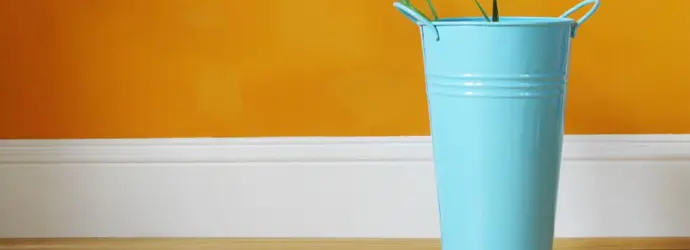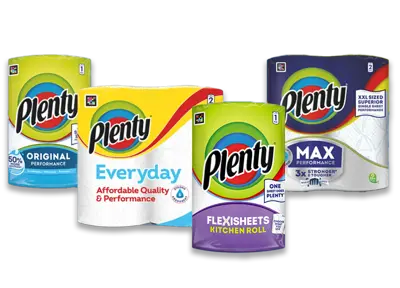
Whoever got you flowers was clearly showing you a bit of love. And you can show your appreciation by keeping those flowers out of the green, sludgy vase water that builds up. And as much as we love confetti, dead petals falling and crunching underfoot in the living room probably isn’t the best bit about flowers.
So, here’s how to keep bouquets fresh, how to keep roses alive, and the tricks to keeping cut flowers fresh for longer.
Keeping cut flowers fresh in transit
If you’re taking flowers to someone, you’ll want to know how to keep flowers fresh on their journey. A good thing to do is to wrap the cut ends of the stems in damp kitchen roll, and keep them out of direct sunlight.
Tip
Use kitchen roll that’s strong and super absorbent, like Plenty The Original One. It will help stop the stems sucking up air and dust.
Step-by-step guide for how to keep cut flowers fresh
Getting flowers is exciting, and you’ll keep flowers fresh for as long as possible. Here’s what to do:
- Clean your vase. Put on your rubber gloves, grab a sponge, and use hot water with a little bleach or liquid soap to clean off any dead daffodils or rotting roses. Then let it air-dry upside down.
- Let the water sit. It’s fine to fill your vase with tap water, but it’s a good idea to let the water settle before adding your flowers. That’ll allow air bubbles to escape – otherwise they can block water uptake. It’ll also let the water come to room temperature – which is good because flowers prefer warmer water.
- Add flower food. Proper flower food is made up of bleach (to get rid of bacteria), sugar (for energy) and citric acid (to dissolve air bubbles and balance the water’s PH level). And some say talking to them helps them grow too. Time to think of some conversation starters…
- Prepare the stems. Measure the right height by placing stems next to the vase. Remove any leaves below the waterline to stop bacteria growing (and that sludge appearing). Cut the stems at an angle with something sharp – this ensures the stem isn’t crushed, and creates a larger opening for food and water. Then, place them straight into the water.
- Choose the perfect location. Your flowers will like a cool spot, away from drafts, direct sunlight and radiators. And try to keep them away from fruit too – fruit releases ethylene gas, which poisons cut flowers.
The best way to keep flowers fresh based on type
A clean vase and the right food will help all types of cut flowers look their best. But did you know the amount of water can make a difference? Here’s how to keep flowers alive depending on their type:
- How to keep roses alive. Flowers with woody stems (like roses) prefer a deep drink, so fill the vase two thirds full. Remove their outer ‘guard’ petals and try not to touch the inner petals.
- How to keep tulips alive. Flowers with softer stems (like tulips) prefer a shallower drink, so fill the vase just under half way. Since they bend towards light, rotate your vase daily, and place them in a tall vase that supports two thirds of the stem length so that they don’t jump out the vase when you’re not looking.
How to keep flowers fresh with proper maintenance
You probably won’t be able to stop staring at your brilliant flowers. Luckily, checking them is a key step in how to keep cut flowers fresh for as long as possible.
Check them every couple of days and top up their water – if the water’s gone murky, refill the vase with fresh water using the instructions above. Hold the stems rather than the heads to move your blooms, and use a fork (a clean one, not one you’ve just finished your spaghetti with) or spoon to remove any fallen petals or leaves. And then cut at least an inch from the bottom of the stems before placing them back in clean water.
Giving flowers is an expression of love, but it’s up to you to take care of that love! Look after your flowers and let their thriving blooms speak for themselves – don’t leave petals everywhere or turn clean vase water into a green sludgy leaf soup. Especially now you know how easy being a flower-parent can be!
You’ve kept your flowers alive, but what happens when they die?
If you’ve followed our advice, congratulations, you can keep flowers fresh for longer! Unfortunately, fresh flowers don’t last forever, and they’ll begin to wilt and eventually die. It's a part of life! But what can you do with dead flowers?
To start with, do not throw them in the bin! Fresh or dead flowers are excellent additions to your compost heap. Dead flowers can be considered ‘brown’ and ‘green’ waste - both perfect for composting – and will eventually decompose to form great nutrition for your soil. Not familiar with composting? Don’t worry. Read our article 'What does composting mean, and how does it work?' and become a composting expert in no time.
Tip
Composting your dead flowers is a great way to turn waste into something positive! But did you also know that Plenty Original kitchen roll sheets are also now compostable? That’s certified compostable sheets* for compostable messes!
Want to know more about Plenty’s compostable kitchen roll sheets? Check out the answers to your frequently asked questions.
*Plenty kitchen towels are certified as home and industrially compostable according to NF T 50-800 and EN14995.
Related articles
5 top tips for houseplant care
Not sure how often you should water plants or where to put them? Click here for houseplant care tips to help you grow your indoor jungle.

How to press flowers at home
Dried flowers look beautiful on greetings cards or artwork. Learn how to press flowers for framing by using our guide to the best way to press flowers.

A beginner's guide to growing from cuttings
How do you take a cutting from a plant? Learn how to do cuttings from softwood and hardwood, and how to plant cuttings to help them take root and grow.

How to ripen green tomatoes in 3 ways
Learn how to ripen tomatoes off the vine. Discover the best way to ripen green tomatoes in a paper bag, on a windowsill and upside down, here.

2 easy ways to make homemade musical instruments for kids
Looking for easy ways to have fun with your kids while teaching them how to recycle? Learn how to make musical instruments from waste material.

Why is my cat being sick? Symptoms, causes, and solutions
“Why is my cat sick?” Learn about the signs of illness in cats, the reasons why your feline friend might be sick, and how to treat a sick cat at home.



